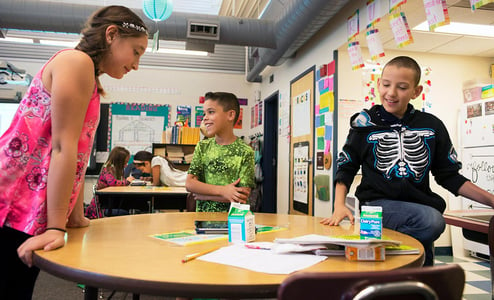
Originally published Jan 23, 2020 by Allie Kallmann
A few years into teaching early childhood, I applied to work at a school that does incredible work in the local community. I was thrilled to get an interview but realized very quickly that, even though the environment was supportive and the students were wonderful young people, I was much too intimidated to work there.
That’s because it was a middle school, and 5th graders are, generally speaking, a tough crowd. Though, to my surprise, the teachers at this school seemed to be able to keep students’ focus, have rich instructional conversations, stick to their lesson plans, and budget their time well enough that when students asked questions, responses were discussions, not corrections. The kids loved their school and their teachers, and it showed in their day-to-day interactions. I left my interview with an increased appreciation for the teaching team’s skillful behavior management and relationship-building…and lots of questions about how they do it.
There are hundreds – probably thousands – of scholarly articles that examine how teachers master student engagement. To my admiring eyes, it looked like the middle school team had some kind of magical tween-wrangling powers. But what, specifically, were they doing to help students participate and like it? One recent academic article used CLASS as a framework to look at teachers’ practices and how they related to 5th and 6th grade students’ emotional and behavioral engagement.
Tracking students’ engagement across the year
In this upcoming article in Teaching and Teacher Education, Sarah McKellar, Kai Cortina, and Allison Ryan from the University of Michigan dug in to the teaching practices used in 54 5th and 6th grade math and science classrooms. Using the Upper Elementary CLASS, observers captured a snapshot of the classroom early in the school year. Then, they asked students to complete a survey to assess their engagement in the fall and again in the spring. One would expect that students in classrooms with more effective teaching practices would become more engaged in the class as the year went on.
What, exactly, do we mean by engagement? In this case, two related but distinct types of engagement were examined: emotional, whether and how students feel positive about the class; and behavioral, “the extent to which students try hard, participate in classroom activities, exert effort, pay attention, and persist.”
Students rated themselves on several different statements related to each of these types of engagement on an existing rating scale. In general, students’ self-ratings are similar to the ratings given by their teachers, and those ratings are in turn related to students’ academic achievement. The research – and teachers’ experiences – show that both emotional and behavioral engagement are important. So, how did teaching practices relate to each type?
Bringing enjoyment to learning
Let’s start with emotional engagement. Previous research has shown a relationship between the domains of Emotional Support (the ways teachers create a warm, supportive, respectful classroom environment) and Classroom Organization (the ways teachers manage students’ behavior, time, and attention) with these types of positive feelings about the classroom environment. The authors of this study hypothesized that they would find similar relationships.
In fact, they found that the most substantial relationship was with the dimension of Regard for Student Perspectives, within the domain of Emotional Support. This specific dimension looks at the extent to which teachers emphasize students’ ideas and preferences and provide opportunities for students to make choices and take responsibility. In classrooms where teachers gave students the chance to take the lead and interact meaningfully with their peers, students were more excited about the learning they were doing in the class.
Getting students to buy in
And what about behavioral engagement? The strongest relationship came from the domain of Instructional Support. This is "the ways in which teachers implement lessons and activities to engage students in learning and promote cognitive development, as well as how they use feedback to help students learn." More specifically, the dimension of Quality of Feedback predicted both how behaviorally engaged students were in the spring and also how much this engagement grew over the year.
Teachers who score well on Quality of Feedback respond thoughtfully to students’ ideas, scaffold academic content based on group and individual needs, and engage students in productive, constructive back-and-forth exchanges. It’s not surprising that students in these classrooms would be participating more, trying harder, and paying better attention. When teachers meet students at their level and push them forward, students rise to the occasion and push themselves as well.
Putting conclusions to work
When we look at the academic literature about CLASS, it can sometimes seem obvious. Of course students enjoy it when they are respected! Of course they try harder when someone is encouraging and pushing them! What CLASS helps us do is break down these teaching behaviors and strategies to focus on what really matters. While most educators know that these are good things to do, this paper and other research on student engagement continue to show teachers and those who work with them just how important engagement is and how to improve their teaching practices.
Want to get more tips for success in your program? Join us at InterAct to learn more about getting and keeping students engaged. We hope to see you there!
Citation: McKellar, S.E., Cortina, K.S., & Ryan, A.M. (2020). Teaching practices and student engagement in early adolescence: A longitudinal study using the Classroom Assessment Scoring System. Teaching and Teacher Education, 89. Retrieved from https://doi.org/10.1016/j.tate.2019.102936.

.png?width=855&name=Copy%20of%20InterAct%20Email%20Header).png)